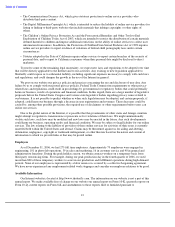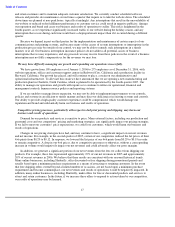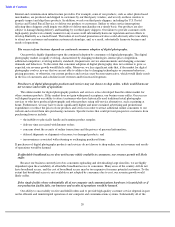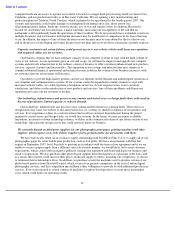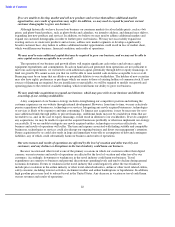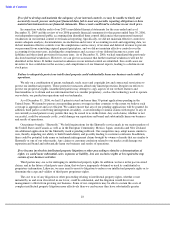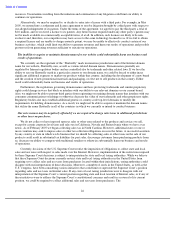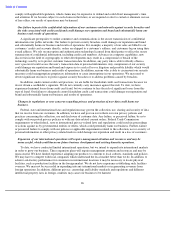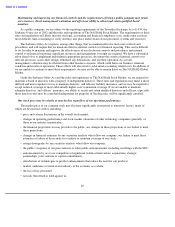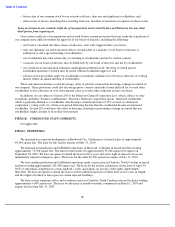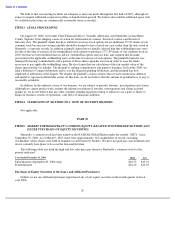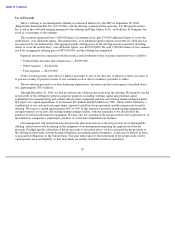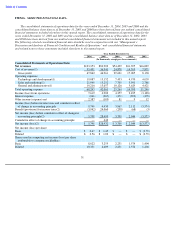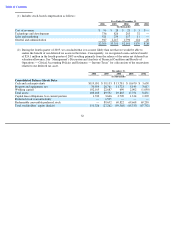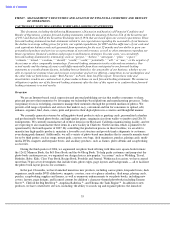Shutterfly 2007 Annual Report Download - page 28
Download and view the complete annual report
Please find page 28 of the 2007 Shutterfly annual report below. You can navigate through the pages in the report by either clicking on the pages listed below, or by using the keyword search tool below to find specific information within the annual report.
Table of Contents
If we fail to develop and maintain the adequacy of our internal controls, we may be unable to timely and
accurately record, process and report financial data, fail to meet our periodic reporting obligations or have
material misstatements in our financial statements. These events could lead to a decline in our stock price.
In connection with the audit of our 2005 consolidated financial statements for the year ended and as of
December 31, 2005 and the review of our 2006 quarterly financial statements for the quarter ended June 30, 2006,
our independent registered public accounting firm identified three control deficiencies that represented material
weaknesses in our internal control over financial reporting. Specifically, we did not maintain effective controls to
ensure adequate analysis, documentation, reconciliation and review of accounting records and supporting data, we
did not maintain effective controls over the completeness and accuracy of revenue and deferred revenue to prevent
our personnel from reinstating expired prepaid print plans, and we did not maintain effective controls over the
accounting for income taxes, including the completeness and accuracy of our deferred income tax assets and
liabilities and the related provision for income taxes. As of December 31, 2006, we had remediated the previously
disclosed material weaknesses. However, we can give no assurance that further material weaknesses will not be
identified in the future. If further material weaknesses in our internal control are identified, this could cause our
investors to lose confidence in the accuracy and completeness of our financial reports, leading to a decline in our
stock price.
Failure to adequately protect our intellectual property could substantially harm our business and results of
operations.
We rely on a combination of patent, trademark, trade secret and copyright law and contractual restrictions to
protect our intellectual property. These protective measures afford only limited protection. Despite our efforts to
protect our proprietary rights, unauthorized parties may attempt to copy aspects of our website features and
functionalities or to obtain and use information that we consider proprietary, such as the technology used to operate
our website, our production operations and our trademarks.
As of December 31, 2006, we had 15 patents issued and more than 30 patent applications pending in the
United States. We intend to pursue corresponding patent coverage in other countries to the extent we believe such
coverage is appropriate and cost efficient. We cannot ensure that any of our pending applications will be granted. In
addition, third parties could bring infringement, invalidity, co-inventorship or similar claims with respect to any of
our currently issued patents or any patents that may be issued to us in the future. Any such claims, whether or not
successful, could be extremely costly, could damage our reputation and brand and substantially harm our business
and results of operations.
Our primary brand is “Shutterfly.” We hold registrations for the Shutterfly service mark in our major markets of
the United States and Canada, as well as in the European Community, Mexico, Japan, Australia and New Zealand.
An additional application for the Shutterfly mark is pending in Brazil. Our competitors may adopt names similar to
ours, thereby impeding our ability to build brand identity and possibly leading to customer confusion. In addition,
there could be potential trade name or trademark infringement claims brought by owners of marks that are similar to
Shutterfly or one of our other marks. Any claims or customer confusion related to our marks could damage our
reputation and brand and substantially harm our business and results of operations.
If we become involved in intellectual property litigation or other proceedings related to a determination of
rights, we could incur substantial costs, expenses or liability, lose our exclusive rights or be required to stop
certain of our business activities.
Third parties may sue us for infringing its intellectual property rights. In addition, we have in the past received
claims, and in the future a third party may claim, that we have improperly obtained or used its confidential or
proprietary information. Likewise, we may need to resort to litigation to enforce our intellectual property rights or to
determine the scope and validity of third-party proprietary rights.
The cost to us of any litigation or other proceeding relating to intellectual property rights, whether or not
initiated by us and even if resolved in our favor, could be substantial, and the litigation would divert our
management’s efforts from growing our business. Some of our competitors may be able to sustain the costs of
complex intellectual property litigation more effectively than we can because they have substantially greater
23


